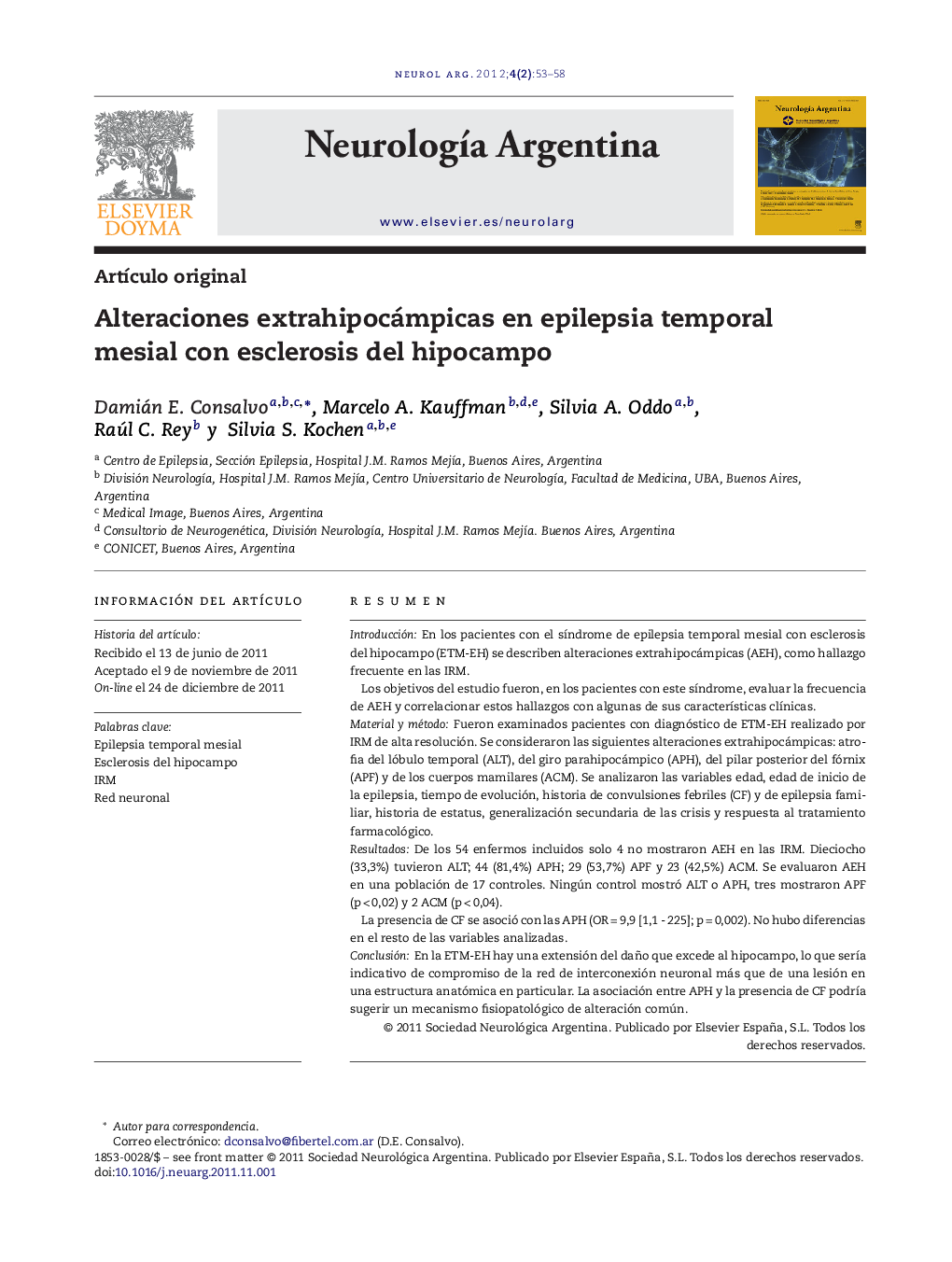| Article ID | Journal | Published Year | Pages | File Type |
|---|---|---|---|---|
| 3076909 | Neurología Argentina | 2012 | 6 Pages |
ResumenIntroducciónEn los pacientes con el síndrome de epilepsia temporal mesial con esclerosis del hipocampo (ETM-EH) se describen alteraciones extrahipocámpicas (AEH), como hallazgo frecuente en las IRM.Los objetivos del estudio fueron, en los pacientes con este síndrome, evaluar la frecuencia de AEH y correlacionar estos hallazgos con algunas de sus características clínicas.Material y métodoFueron examinados pacientes con diagnóstico de ETM-EH realizado por IRM de alta resolución. Se consideraron las siguientes alteraciones extrahipocámpicas: atrofia del lóbulo temporal (ALT), del giro parahipocámpico (APH), del pilar posterior del fórnix (APF) y de los cuerpos mamilares (ACM). Se analizaron las variables edad, edad de inicio de la epilepsia, tiempo de evolución, historia de convulsiones febriles (CF) y de epilepsia familiar, historia de estatus, generalización secundaria de las crisis y respuesta al tratamiento farmacológico.ResultadosDe los 54 enfermos incluidos solo 4 no mostraron AEH en las IRM. Dieciocho (33,3%) tuvieron ALT; 44 (81,4%) APH; 29 (53,7%) APF y 23 (42,5%) ACM. Se evaluaron AEH en una población de 17 controles. Ningún control mostró ALT o APH, tres mostraron APF (p < 0,02) y 2 ACM (p < 0,04).La presencia de CF se asoció con las APH (OR = 9,9 [1,1 - 225]; p = 0,002). No hubo diferencias en el resto de las variables analizadas.ConclusiónEn la ETM-EH hay una extensión del daño que excede al hipocampo, lo que sería indicativo de compromiso de la red de interconexión neuronal más que de una lesión en una estructura anatómica en particular. La asociación entre APH y la presencia de CF podría sugerir un mecanismo fisiopatológico de alteración común.
IntroductionIn mesial temporal lobe epilepsy patients with hippocampal sclerosis (MTLE-HS) syndrome, extrahippocampal alterations (EHA) are frequently described on MRI studies. The objectives of the study were, in patients with this syndrome, to evaluate the frequency of EHA and to correlate these findings with some of its clinical characteristics.Material and methodWere examined MTLE-HS patients diagnosed by high resolution MRI. The following EHA were considered: atrophy of the temporal lobe (TLA), of the parahippocampal gyrus (PHA), of the fornix (FA) and the mammillary bodies (MBA). We analyzed the variables age, age at the beginning of the epilepsy, time of evolution, history of febrile convulsions (FC) and familial epilepsy, history of status, secondary generalization of the seizures and response to the pharmacological treatment.ResultsOf the 54 patients included, only 4 of them didn’t show any EHA. Eighteen (33.3%) had TLA; 44 (81.4%) PHA; 29 (53.7%) FA and 23 (42.5%) MBA. EHA were analyzed in a population of 17 controls. Anyone of the controls showed TLA or PHA, 3 showed FA (p< 0.02) and 2 MBA (p< 0.04). The FC was associated to PHA [OR = 9.9 (1.1-225); p = 0.002]. There were no differences in the rest of the variables that were analyzed.ConclusionIn MTLE-HS there is an extension of the damage beyond the hippocampus, which would be indicative of involvement of the neuronal network rather an injury in a particular anatomical structure. The association between PHA and the presence of FC may suggest a common pathophysiological mechanism of disturbance.
